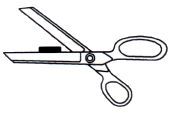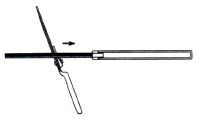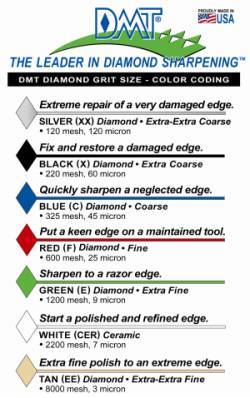When sharpening scissors, it's helpful to remember that the bevel angle is around 75° to 80° - much steeper than the average knife.
Always hold the handle of the scissor blade you are about to sharpen in order to maintain control. Rest the tip of the back edge of the blade on a table at a comfortable height.
Working under a bright light, angle the handle of the scissors until the bevel reflects the overhead light back to you the brightest. At this point the bevel is parallel to the table.
Hold the Diafold® sharpener parallel to the table and stroke into and across the scissor bevel from the hinge joint to the tip of the blade. Usually 5-6 strokes will renew a dulled edge. It may be necessary to work through coarse to fine grit sharpeners if the scissors are intended for fine work.
Rotate the scissors 180° and repeat on the other scissor blade.
ILLUSTRATED SUMMARY:- Align sharpener flush with the bright bevel.

- Stroke smoothly towards the outside of the scissors. Repeat on the other blade.

TIP: Small burr on each sliding surface can be wiped off with a single, light stroke on the flat back of the scissor.

By working through the DMT® system of progressively finer grits, you will quickly achieve a razor sharp edge on quality knives and tools. The DMT® diamond products are colour-coded for identification. In our product descriptions, coloured diamond shapes denote the specific grits in which each model is available.
Which grit you should use depends on... How often do you sharpen? How dull do you let your knife or tool edge get before you re-sharpen it? How sharp is sharp enough for you? Ask yourself these questions, and then read the grit descriptions (left) to determine which grit(s) best suits your needs. Hint: the pros use more than one grit & move from coarser to finer grits as they sharpen.







